Board: 2023-2024 Arbor Bryan Iguchi Pro Camber, 162 cm
Test Locations: Alyeska Resort, Chugach Mountains, & Turnagain Pass, AK
Test Duration: 31 days
Available Sizes: 153, 156, 158W,159, 162, 163MW, 167W cm
Blister’s Measured Weight (162 cm): 3.074 kg / 6.77 lbs
Stated Dimensions (162 cm): 296-254-295 mm
Stated Sidecut Radius (162 cm): 9-8.1-9 m
Camber / Rocker Profile: parabolic camber
Stated Flex Rating: 7/10
Core Construction: poplar/paulownia + center bamboo stringers + fiberglass laminate
Base: “Sintered Plus”
Boots Used: K2 Ender, Nitro Select, K2 Orton
Bindings Used: Now O-Drive, Jones Apollo

Intro
Founded in 1995 in California, Arbor has been making high-end (and beautiful) snowboards and skateboards ever since. Arbors founder, Bob Carlson, built the company with the mission statement to: “blend innovative construction, with aspects of traditional craftsmanship, and a steadfast commitment to sustainable materials and methods.”
Arbor boards always stood out to me as a kid, due to their beautiful wood top sheets and snappy feel, and I was excited to get to spend some significant time on one this season.
The Bryan Iguchi Pro Camber (as you might guess, the pro model of boarding legend Bryan Iguchi) stood out to me as an interesting 1-board quiver option that could handle pow and everyday all-mountain riding. Specifically, it seemed like a solid choice for riders looking for versatile freestyle / all-mountain board that was designed for powerful edging and carving, yet still able to throw down off side hits and natural features (or even park jumps).
Although I often ride exaggerated directional shapes, I appreciate traditionally cambered, “medium” to “stiff” boards that retain a crisp snap / pop for a more freestyle approach to riding… which led to my interest in the Arbor Iguchi Pro Camber. Here’s what I’ve found this winter:
What Arbor Says about the Iguchi Pro
“Time-tested relevance, timeless appearance, and shape engineered by snowboard legend, Bryan Iguchi. Bryan’s spanning knowledge and experience of freestyle snowboarding are brought to life in his signature model. The versatility and performance of Guch’s thoughtful design make the Bryan Iguchi Pro the perfect pick for optimal rideability, ‘having fun on it, on any mountain, in any condition.’”

Construction
Although I have yet to spend a full season on the Iguchi Pro, I have so far been pretty pleased with its feel and seemingly robust construction. The Iguchi Pro features a poplar and paulownia wood core with bamboo stringers along the center of the board, the latter of which are intended to increase longitudinal pop and control.
The core is laminated with triaxial and biaxial fiberglass and capped off with an ash veneer top sheet. The Iguchi has a “sintered plus” base, which is reportedly a mid-density base for increased speed and durability. In terms of wax retention, I feel as though it is a touch slower and seems to dry out a bit faster than the “Speed Formula HD” base of the Nitro Squash or the “sintered 8000” base of the Jones Storm Wolf, but this could be largely attributed to the actual wax and conditions being ridden.
The Iguchi Pro has fully wrapped metal edges, which I have grown to appreciate over the years for their increased protection and durability on and off the mountain. In addition to the fully wrapped edges, the Iguchi Pro also has fully wrapped sidewalls aimed to increase the life and durability of the board.
I’ve ridden the Iguchi Pro a fair bit this season (31 days), and I have not had any issues with the durability or noticed any damage to the top sheet or edges. I’ll update this section as needed throughout the season and beyond, but so far, so good.
True to Arbor’s mission statement and company ethics, the production and construction of the Iguchi Pro were developed with reduced environmental impact in mind. Specifically, they use recycled steel edges, wood top sheets, bio-based resin, and Arbor claims that the boards are manufactured 100% by solar energy (SWS Dubai factory).
Shape
The Iguchi Pro is a semi-directional shape with a unique angular tip and tail. Although it is branded as a directional board, I feel as though it rides the fence between a true directional board and a directional twin. Its slight 1 mm taper at the tail and 0 cm setback make it ride like a twin, despite the different tip and tail shape. For reference, its tip-waist-tail widths are 296-254-295 mm for the 162 cm length.
As a rider who spends a lot of time on swallowtails, fish, and other directional shapes, I do wish there was a 1-2 cm setback to make the nose feel a touch longer for powder riding. Several times in deep, heavy snow, I got pitched over the nose and have since adjusted my stance back as far as I can. For deeper days (especially on flatter terrain) I appreciate the longer, floaty nose of boards like the Season Aero and Ride Commissioner, with their 2-3 cm setback. However, I don’t think this would be as much of an issue for riders who are used to twin shapes (more on this later).
The sidecut of the Iguchi Pro is stated at 9-8.1-9 m for the 162 cm I’ve been riding. Looking elsewhere, this is very similar to the Jones Ultra Mountain Twin (8.1 m), with both boards utilizing a serrated Grip Tech / Traction Tech design. Arbor’s Grip Tech (similar concept as Mervin’s Magnetraction, Jones Traction Tech, etc.) is the result of the intersections between 3 different radii, in this case, 9 m, 8.1 m, and 9 m. The intersections, or traction bumps, in the sidecut create additional contact points near the toe and heel of the binding to improve control on firmer and icy conditions.
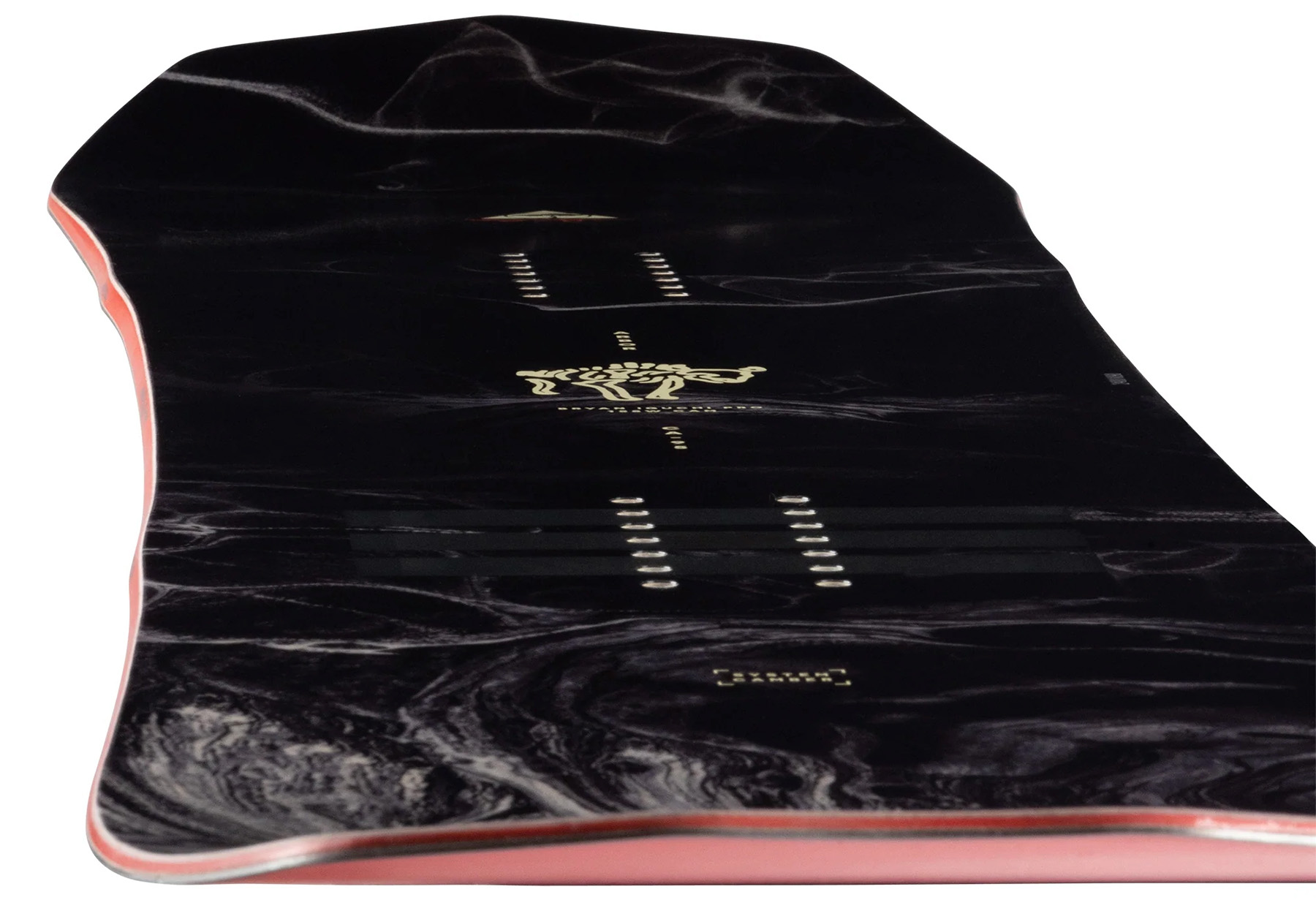
In addition to grip, the bumps are meant to act as pivot zones to aid in maneuverability. Depending on the brand and particular model, I’ve found this sort of serrated sidecut to take some getting used to, particularly on ice when the feel of the sidecut is more pronounced. In the case of the Bryan Iguchi Pro Camber, Arbor’s Grip Tech has been a bit more intuitive and smoother than some of the Jones, Gnu / Lib Tech, and Rossignol implementations I have been on. Shapes and construction play a big role in the overall performance, but it does seem that the Iguchi edges more intuitively, smoother, and in a more controllable fashion than the Ultra Mountain Twin, which I have had wash out on me numerous times during quick, wide carves.
To further complement its parabolic camber and serrated sidecut, the Iguchi Pro base has a 3° bevel / fender along the leading edge of the tip and tail. This is intended to improve turning, buttering, spinning, and performance in powder. The tip and tail do feel pretty smooth and minimally catchy while transitioning from edge to edge.
Camber Profile
The Iguchi Pro Camber is, in fact, cambered. Arbor offers many of their shapes in both rockered and cambered versions, though it seems the Iguchi Pro Rocker was phased out in 2020.
The Iguchi Pro Camer’s camber profile is a parabolic arc that reportedly blends five different radii, reducing the amount of camber towards the tip and tail and reportedly maxing out at 6 mm of camber height in the middle for the 162 cm length. This multi-radii design is meant to make the leading edge less aggressive for smoother carving.
I have grown partial to cambered boards (including those that feature some early rise / rocker at the tips and/or tails) due to their generally better edge hold and increased “snap” when compared to most models that feature rocker-dominant profiles.

Compared to some other freestyle / freeride boards I have recently been on, including the Jones Ultra Mountain Twin, Weston Range, Ride Commissioner, and Season Aero, the camber in the Iguchi Pro is slightly more dramatic, and extends farther toward the tip and tail, resulting in the least amount of rocker in the tip and tail. I’ll get into how this impacts on-snow performance in the Full Review section, below.
Overall the Iguchi Pro’s parabolic camber profile, coupled with its flex pattern and construction, makes it feel snappy and produces powerful pop and ollies. I do feel this camber profile is more suited to advanced riders since it is less forgiving than above mentioned boards (again, more on that below).
Flex Pattern
Arbor rates the Iguchi Pro Camber at 7/10 for stiffness but I’d say it feels a bit stiffer when compared to boards from other brands rated around the same number, though it’s possible I haven’t yet fully broken in the Iguchi Pro’s flex pattern.
The Iguchi Pro’s flex pattern feels well suited for a pretty aggressive approach to all sorts of riding, but it’s still soft enough to feel playful and snappy when popping off jumps and other features. It is stiff enough that it takes a lot of rider input to butter and drive short-radius turns, but the Iguchi Pro’s flex feels fairly uniform throughout the length of the board, leading to a consistent and smooth feel when hitting jumps and getting airborne.
This versatile flex pattern feels most comparable to one of my favorite directional twins, the Weston Range. As for other comparisons, the Iguchi Pro is considerably stiffer than the Season Aero, slightly softer than the Jones Ultra Mountain Twin, and substantially softer than the Ride Commissioner.
Overall, I think the Iguchi Pro’s flex pattern seems well suited for its intended use and shape. It’s pretty stable at high speeds but retains a snappy feel for boosting jumps and natural features.
So, that’s the design of the Iguchi Pro Camber — now let’s get into how it all translates in various snow conditions and terrain:
FULL REVIEW
Powder
Andrew Forward (5’ 11”, 165 lbs /180 cm, 75 kg): With a near-twin shape, the Iguchi Pro was not as enjoyable nor as buoyant as more directional, powder-oriented shapes, which was not surprising. That said, the Iguchi Pro performed pretty well in shallower conditions (less than 8” / 20 cm), whether dry or heavy and wet.
One of the more notable issues in deep snow was the board’s lack of flotation, even though I fell right around the middle of the recommended rider weight range for the 162 cm. Although only a few mm narrower than the Jones Ultra Mountain Twin, Weston Range, and Season Aero, the Iguchi Pro definitely falls a bit short of those boards in terms of flotation on moderate to bottomless powder days.
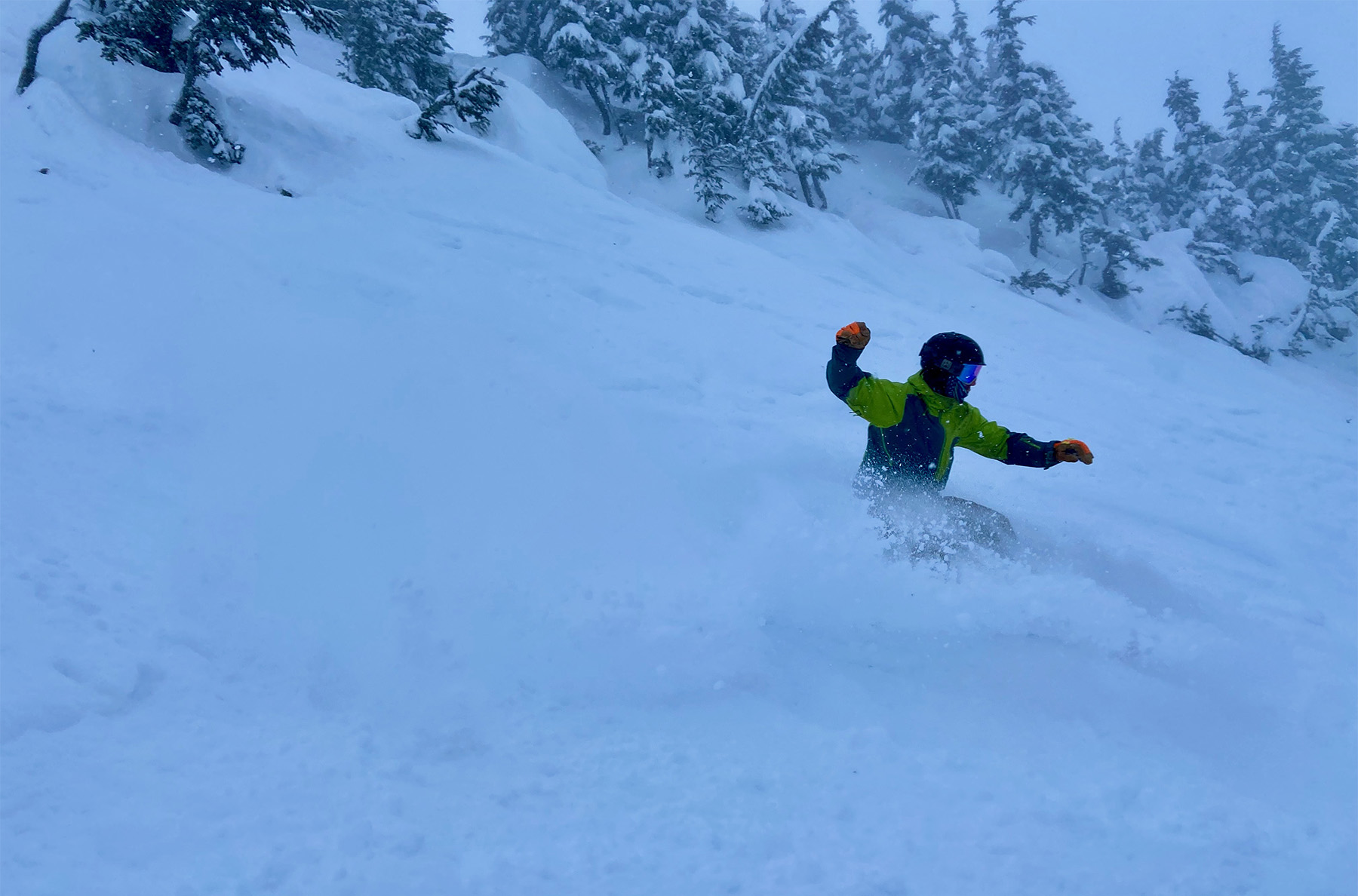
As mentioned before, I prefer directional swallowtail and fish shapes for most general riding, but especially on deep powder days. This is partially due to personal preference, and also at least partially due to where and what I ride — the maritime snowpack of Alyeska resort and the surrounding Chugach mountains. As a result, I have become accustomed to a large, floaty nose and less volume in the tail, which makes powder riding less fatiguing. However, even for the directional twin category, I feel the Aero, Range, and Ultra Mountain Twin perform better for the deeper days due to their increased setback and larger surface areas.
For shallower powder days, though, the Iguchi Pro does an excellent job, particularly at higher speeds where deep carves touch the firmer subsurface. The Iguchi Pro Camber has been a blast when I can feel the base on a pow day (i.e., not bottomless, where directional boards thrive). This makes it seem better suited to continental snow packs with lower-density snow, where the base is still grippy, you’re more frequently feeling it on pow days, and that base in part dictates the turn.
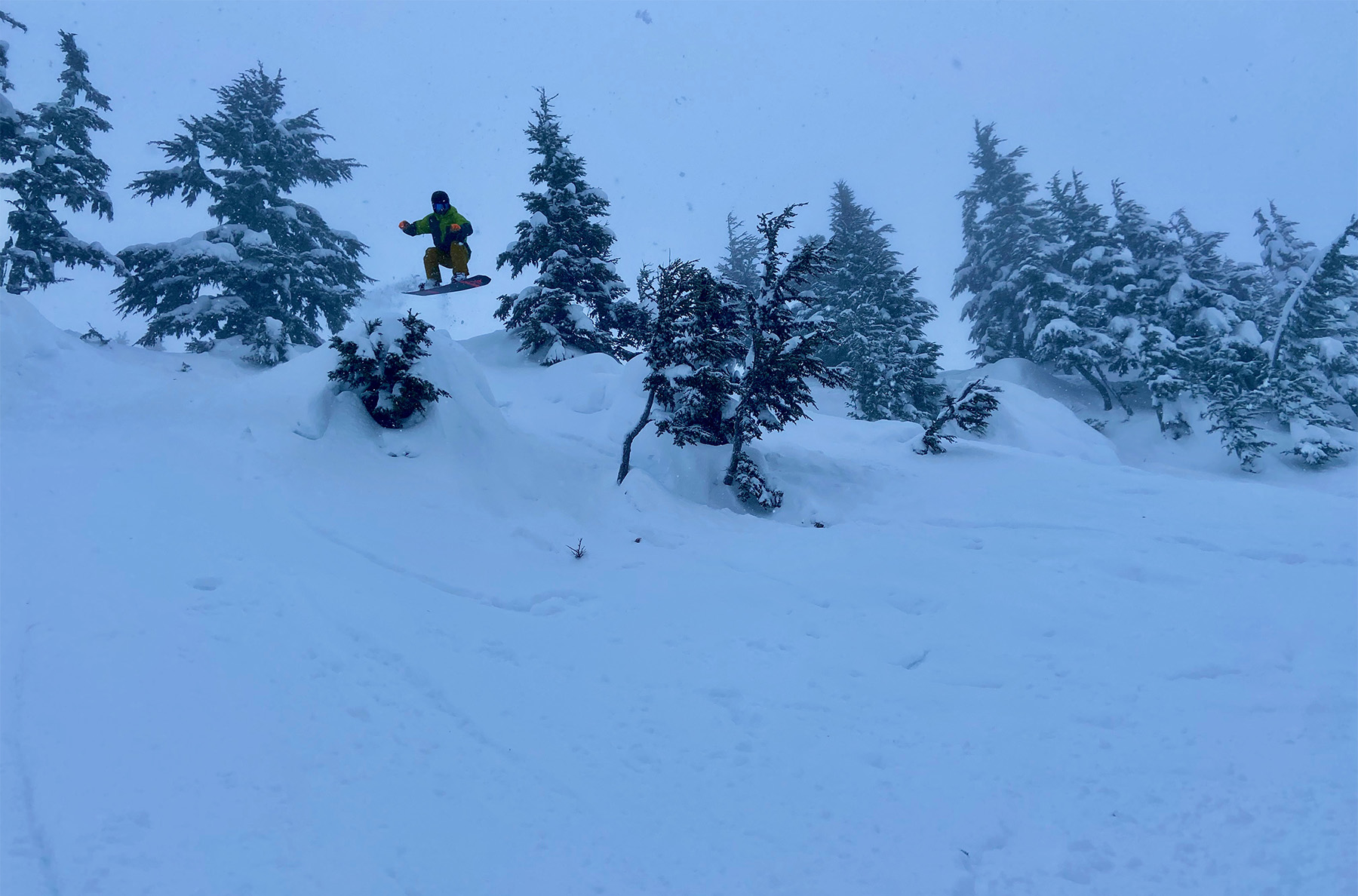
I do think the Iguchi Pro Camber’s flex pattern is well-matched to the rest of the board’s design and does a great job of dissipating bumps and tracked-up snow while feeling stable and not requiring much leg work. In general, I found that setting the bindings back as far as I could helped with the Iguchi Pro’s powder performance and nose flotation, especially when landing drops and cliffs, but as mentioned above, this board is designed around a -0 cm setback, so the options there are somewhat limited.
Soft Chop
The flex and shape of the Iguchi Pro Camber make it a very fun option for blasting through soft chop and tracked snow. It’s stiff enough to feel stable when hammering over rough conditions without overly fatiguing the legs, especially when the snow is wet and heavy (where many other boards often struggle).
That said, the Iguchi Pro doesn’t feel extremely stiff to the point that it feel like it seriously compromises on snap and general playfulness (something that could be said of the Ride Commissioner and Jones Ultra Mountain Twin).

Because of this combination, the Iguchi Pro Camber has become one of my go-to picks on the days after a storm, or later in a pow day when conditions are soft but a bit tracked out, there are plenty of soft pow landings, and the side hits and jumps are well developed — encouraging me to send airs and throw tricks I probably shouldn’t anymore. It reminds me a lot of the Weston Range in terms of its generally freestyle-friendly ride, but the Iguchi Pro has just a bit more spine to it, making it feel more stable in chop and bumpy run-ins to jumps at higher speeds.
Crud and Variable Snow
Performing similarly as it does in soft chop, the Iguchi Pro edges very well in crud and variable surfaces, and has a stiff enough flex to feel pretty composed in these conditions. I found its Grip Tech sidecut to take a little getting used to on variable-texture surfaces, specifically when transitioning from softer snow to ice while on edge. That’s where I tend to prefer boards with traditional, non-serrated sidecuts, such as the Ride Commissioner, Season Aero, and Nitro Squash.
However, the extra grip on the Iguchi Pro is helpful when navigating extremely icy terrain. Somewhat similar to the Jones Ultra Mountain Twin, the Iguchi Pro feels prone to washing out or skipping on edge when frequently transitioning between edges in firm moguls, but it holds an edge better when making tight-radius turns on icy conditions and really excels when making larger, fast or slow arcs.
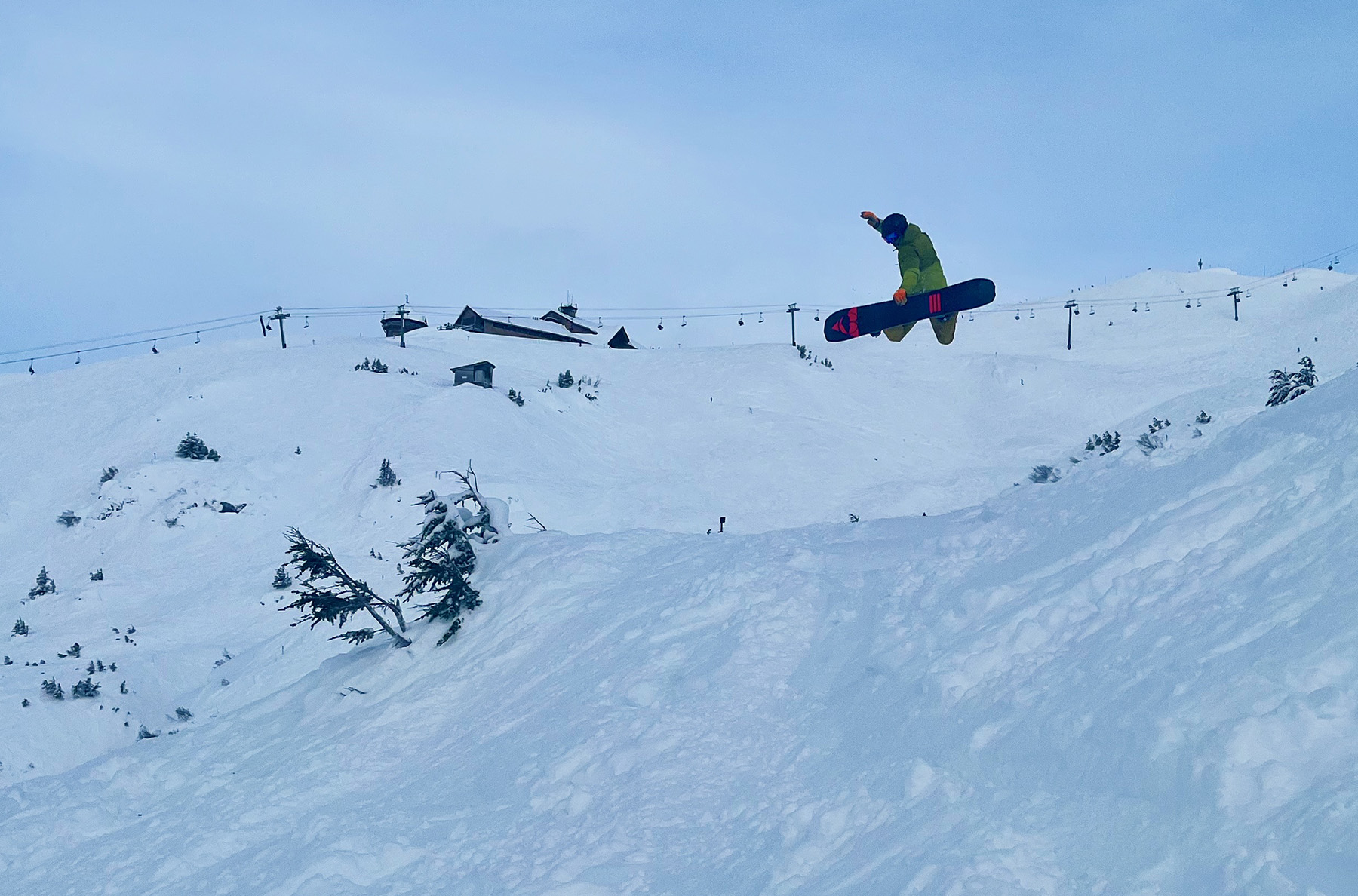
Groomers
Overall, the Iguchi Pro Camber holds an edge well on groomers and is generally pretty solid in this arena for a generalist, do-everything board. However, it would not be my first choice as a dedicated carver for a couple of reasons — many of which are inherent to many boards that share some of its design traits.
In general, I find that more directional shapes (e.g., Aero, Squash, & Comissioner) feel more controllable, powerful, and intuitive at higher speeds on edge, but the Iguchi Pro performs quite well on edge for being a near-twin shape.
With my US Men’s size 9 foot, I didn’t encounter any significant issues with toe or heel drag when laying the board on edge, but someone with a larger boot may want to opt for one of the wide or medium-wide sizes. For reference, the regular 162 cm board I’ve been testing has a 254 mm waist. The Iguchi Pro Camber is available in a 158W (266 mm waist), 163MW (263 mm waist), and 167W (270 mm waist).
That said, the Iguchi Pro still offers plenty of grip and support for high-speed groomer carving and can enable powerful, laid-over turns. It is fairly easy to throw around and switch from edge to edge, despite its full camber profile, which is likely thanks to its narrower shape and 3° fenders along the tip and tail. The Iguchi Pro also feels surprisingly easy to ride switch on groomers, despite the directional appearance of its tip and tail shape, being very comparable to the Ultra Mountain Twin and Range in that regard.
Who’s It For?
The Iguchi Pro Camber seems ideal for high-intermediate to expert riders looking for a powerful all-mountain freestyle board. I think it will be most appealing to folks with freestyle roots who now spend more time boosting side hits and cliffs than purely lapping the terrain park.
The Iguchi Pro Camber retains many of the all-mountain characteristics essential to riding all sorts of terrain at pace, including impressive edge grip and a well-balanced flex that is snappy but stable enough for hitting chop and crud at higher speeds. This board does require substantially more rider input than a softer park board would, but that energy is translated well into explosive pop and edge hold.
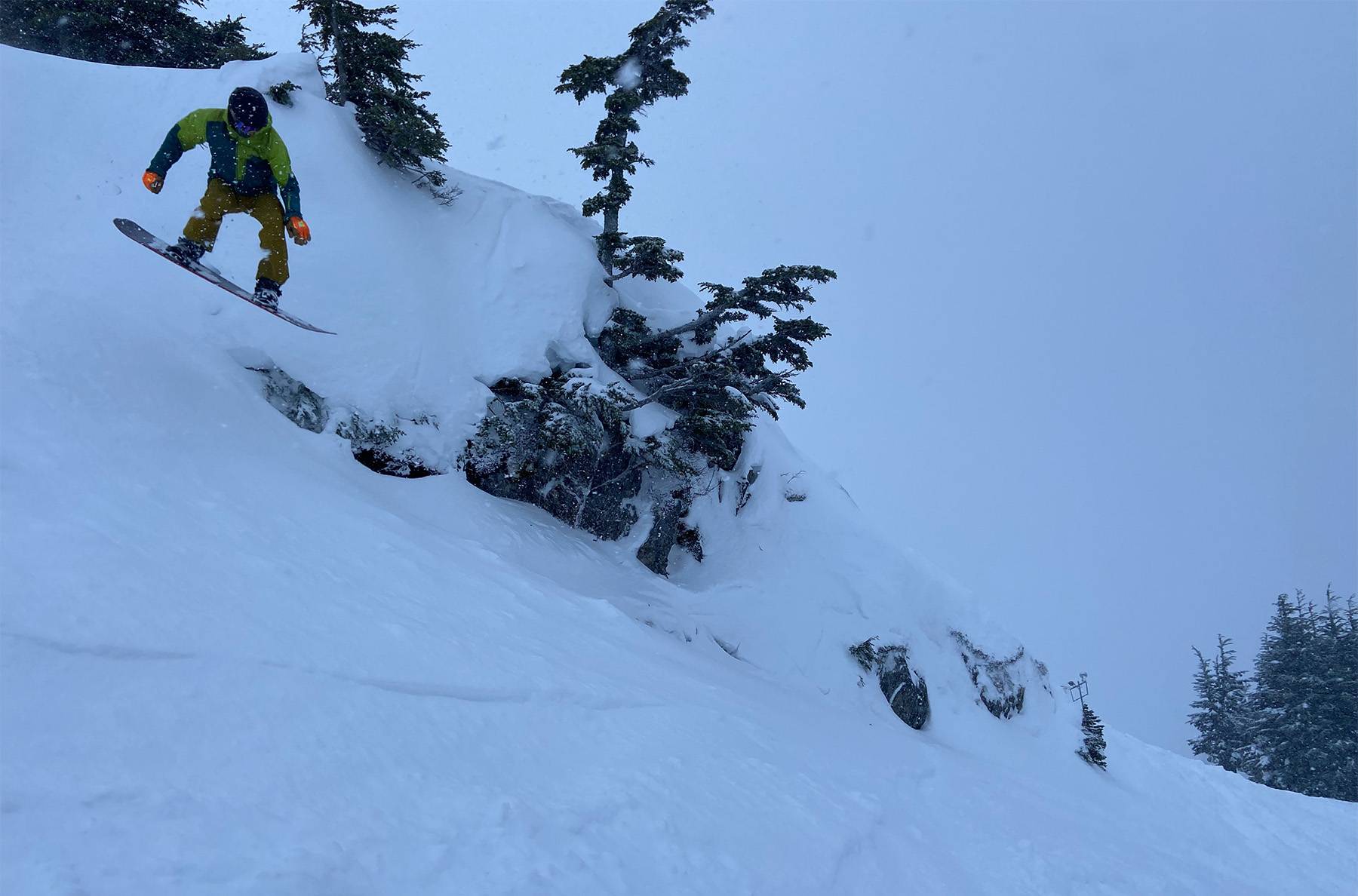

For those who are looking for a board that they’ll consistently ride in more than about 8” / 20 cm of fresh snow (especially heavier pow), it may be worth checking out the Weston Range, Season Aero, Jones Ultra Mountain Twin, or Arbor’s more powder-oriented, more directional Annex Camber. And for riders with larger boots (US Men’s 10+), it may be worth opting for the wider versions, given that the Iguchi Pro is on the narrower side. However, if you’re looking for a responsive, adaptable, pretty stable, freestyle-oriented, directional twin, the Arbor Iguchi Pro Camber definitely warrants consideration.
Bottom Line
The Arbor Bryan Iguchi Pro Camber is a versatile, freestyle-inspired, all-mountain board. Its deep-powder performance isn’t quite what I was hoping for, given where and how I ride, but the Iguchi Pro is very capable on shallower powder days and those days when you can feel the base surface. But overall, it does a nice job of blurring the lines between snappy directional twins and stiffer, harder-charging models; as a result, the Iguchi Pro handles well at high speeds but is playful enough to encourage big airs and sending features all over the hill.



My demoing of the 163 MW, has got me buying one. Everything you’ve said feels right about it. I’m getting to old to be park oriented. But I do enjoy jumps and hitting up all the mountain and powder. I rarely get over 8″ of powder on my days. I might keep my hands on my Yes pyl uninc dcp for those days, but I might only see them a few times a year.